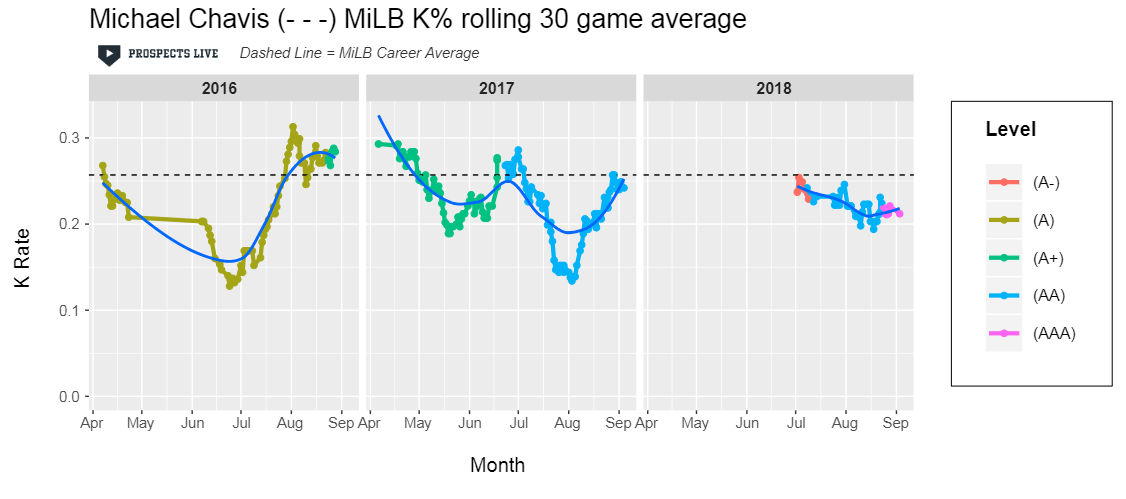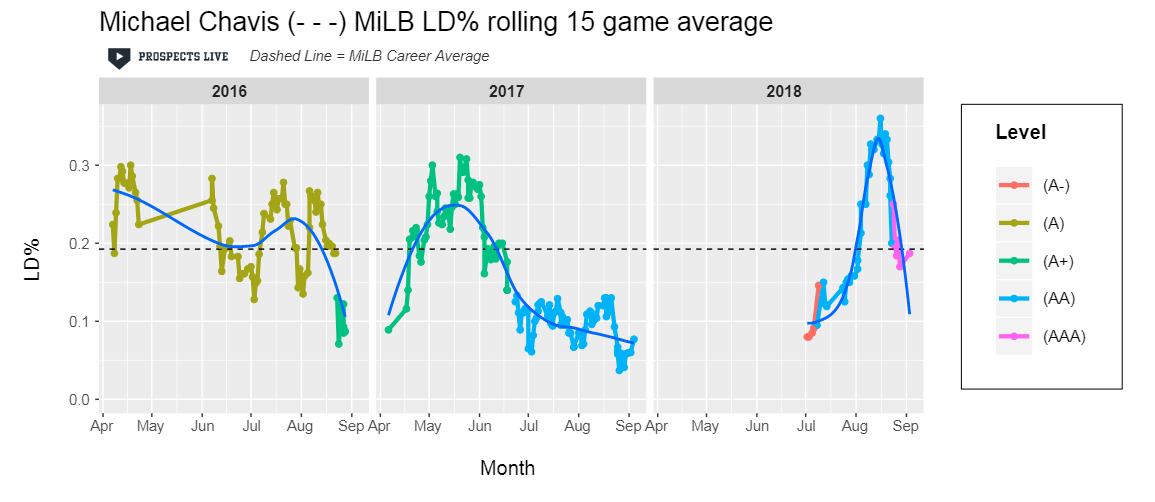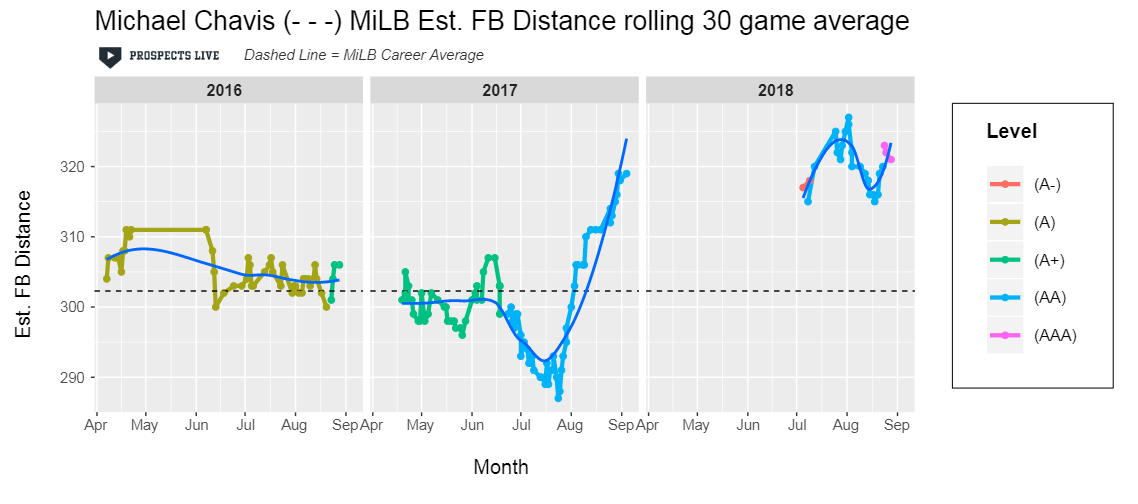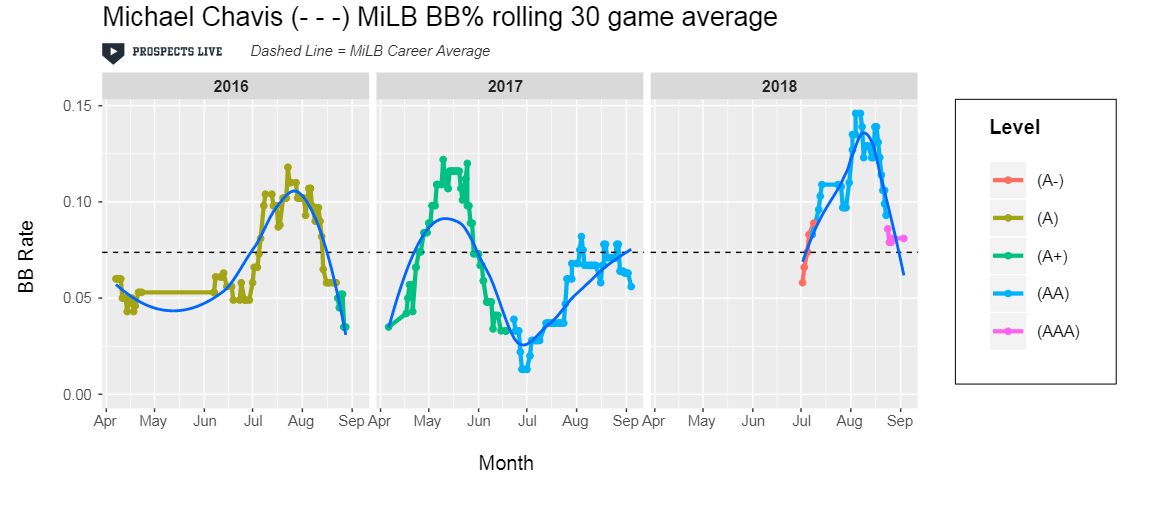Photo courtesy of Bryan Green
We’re a fickle bunch as rankers. Players in a matter of 24 months can see their prospect status fluctuate wildly. Players pop up, breakout, and breakdown, but few have experienced the rollercoaster ride quite like Red Sox infield prospect Michael Chavis. After entering pro-ball as a first-round pick from the prep ranks, Chavis took a few years to really find his footing in full season ball. But in 2017 Chavis broke out in a big way between High-A Salem and Double-A Portland connecting for 31 homers, and gaining attention as one of the better power hitting prospects in the minors.
Then the suspension happened. An 80-game banishment after testing positive for Dehydrochlormethyltestosterone (DHMCT), an anabolic steroid. Immediately the power breakout of 2017 was called into question, and for good reason. While an 80-game suspension would account for half a major league season, it’s closer to two-thirds of a minor league campaign. The lengthy layoff and PEDs stigma all but erased Chavis from the minds of the general collective. It was more than just out of sight out of mind.
The third baseman, sometimes first baseman, and possible keystone option, returned to competitive baseball July 2 with the short season Lowell Spinners. During his last game in Lowell before joining Portland Chavis hit a ball 400+ feet to the opposite field for a homer. It was easy to see the all-fields power Chavis had been known for pre-suspension never left. Three days later Chavis rejoined the Sea Dogs lineup, and he homered again. Over the course of the next two months Chavis slashed .313/.388/.544 between Portland, and a late season look in Pawtucket, showing the skills that earned him high grades the previous year.
Entering 2019, Chavis is likely to return to the Red Sox Triple-A home as he awaits an opportunity with the big league club. So far in the spring, Chavis has made noise hitting three homers in his first four games. His big raw power, and his get-everything swing has caught the attention of Red Sox nation early in the March thaw. So this begs the question: who is Michael Chavis? And what will his role be for the 2019 Boston Red Sox?
Over the course of 2017 and late in 2018 I’ve observed around 40 at bats from Chavis and about 8-10 plays in the field at both third and first base. So I feel comfortable discussing Chavis’ overall skillset, strengths, and deficiencies. First and foremost, Chavis can hit. To say his swing is upper-body heavy would be putting it lightly. Quick hands that are short to the zone, Chavis generates good bat speed, a thunderous sound at the point of contact, and a follow through with an almost exaggerated rotational coil.
Despite a moderate leg kick and all that bat whip, Chavis has maintained fairly consistent contact skills throughout his time in the upper minors. He hits lots of hard consistent line drives at each level, and is a more hit-over-approach type hitter. Not the most attractive profile at the moment, but Chavis’ power+hit allows it to work. Whether his strikeouts stay manageable at the next level is the biggest question. His ability to hang his barrel in the zone, get to pitches in all four quadrants, and drive balls with force to all fields makes him better equipped than most to toe the line between contact hitter and no approach empty power hitting corner infielder. Another attribute in Chavis’ favor is his ability to hit righties and lefties, never showing any drastic splits in any of his extended stops in his career. Meaning he can find himself on each side of the platoon.
Chavis says all the right things about approaching the game from a cerebral standpoint, “nerding out” on all things hitting. He still remains a lower OBP pull hitter without a true position, and it’s still possible his Ks jump to the 30 percent range at the MLB level. These concerns are all very real, but the track record speaks for itself. Over his last 598 minor league at bats, Chavis is slashing .286/.359/.559, with 38 homers, 114 runs, and 114 RBI. Good enough for a wRC+ of 152. Not bad for the 23-year-old on the cusp of the majors. Sure a chunk of that is from his time at High-A Salem, and there’s always the questions of PEDs, but the production is elite. I ranked Chavis number one in my October Red Sox Top 30, and he still remains in that spot. I believe that Chavis has the upside of a 30-homer bat from a corner infield slot, that shouldn’t sacrifice too much in the way of average. Here’s what I wrote in my Red Sox Top 30.
“Between Double-A Portland and Triple-A Pawtucket, Chavis hit the ball with authority to all fields, much like he did all of 2017. There’s still aggression that the best arms will exploit, but he feasts on fastballs and mistakes in the zone. The raw power is a comfortable 70, translating to 60 game power at present. The questions that surround Chavis’ profile at the plate are based around just how quality the hit tool is. I put a 50 on it personally, with the belief early strikeouts struggles at MLB will stabilize around 750-1,000 plate appearances.
Defensively Chavis is a bit of a tweener. Mediocre with the glove, with below average range at third, his strength at his natural position is his plus throwing arm. He’s played some first but at 5-foot-11, he’s not the ideal body for the position.”
You can see in the below charts that the skills in no way regressed in his truncated 2018. His average flyball distance was as high as ever, his wRC+ production climbed throughout the year, and his above average line drive rates returned. His strikeout rates have stabilized since July of 2017, never climbing above 26 percent for any 30-game stretch. In tandem his walk rates rose this year above eight percent for a majority of the season.
Now the question of second base, and where Chavis fits in with the 2019 Boston Red Sox. It’s hard to say for sure just how Chavis inserts into the big picture, but let’s keep a couple of things in mind. First: The Red Sox do not want exceed the luxury tax this season, which they are dangerously close to doing. So options might have to come from within the organization should an injury arise. Second: Their three most questionable positions are third base, second base, and first. While there’s a glut of options at each outside of Rafael Devers, few offer much beyond this season, and the age of players like Dustin Pedroia, Mitch Moreland, Steven Pearce, and Eduardo Nuñez, lead you to believe it might not be the healthiest bunch.
These factors could open up opportunity for Chavis to get some time on the MLB stage. While I’d expect it likely to be at third or first base, the Red Sox have had the former shortstop taking reps at the keystone. Certainly an interesting development for his fantasy owners, but in reality it’s another statement on the state of defensive value at second base with shifting and advanced metrics backing positioning. It’s a nice storyline, and one that gets attention due to the fantasy angle, but in reality it’s not a likely outcome. From my looks at Chavis his footwork isn’t great at his native third, I highly doubt he’d have the agility to turn two with precision. Leading me to believe he’d only play there in a pinch.
In all likelihood, Chavis starts the season in Pawtucket, performs well, as a hitter with his talent should, and is just a 45-minute drive from Kenmore Square should an injury occur. It’s likely to happen with the group on the corners in Boston, and that’s not even considering Chavis could force their hand.
The possibility of hitting even at the bottom of a stacked Boston lineup is a dream scenario. Hitting in a great park for right handed pull-hitters, with the ability to fill in at multiple positions which might make him valuable should some space open on the 25-man roster for any extended period. It wouldn’t shock me if Chavis saw around 250-300 plate appearances, flashing good power, but struggling to hit above .250.
All in all there’s a real opportunity for Chavis if he takes a step forward with his plate discipline and he gets the aforementioned opportunity. Then again, perhaps this is all for naught and Chavis’ true value comes in the way of a trade chip. It’s not the fairy tale scenario but it’s as likely a scenario as any discussed above. In the end there’s one thing I’m certain of: Michael Chavis will have an impact on the 2019 Red Sox.







